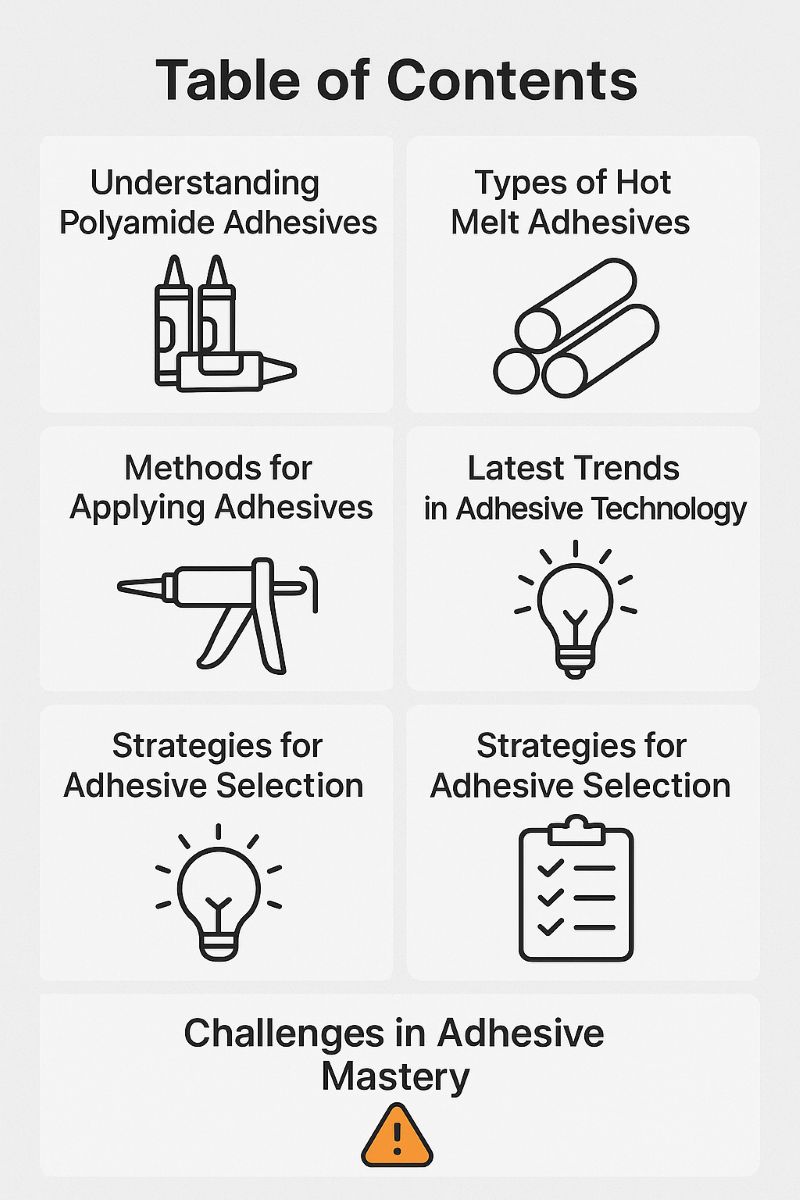
Understanding Polyamide Adhesives
Types of Hot Melt Adhesives
Importance of Polyamide Adhesives
Methods for Applying Adhesives
Latest Trends in Adhesive Technology
Strategies for Adhesive Selection
Challenges in Adhesive Mastery
Frequently Asked Questions (FAQ)
Polyamide adhesives are widely used across industries due to their strong bonding capabilities and resistance to chemicals and high temperatures. These adhesives, derived from synthetic polymers, offer flexibility and durability, making them ideal for challenging applications such as automotive, electronics, filtration, and textiles. Their performance characteristics ensure reliable adhesion even under stress, supporting stable and efficient production processes.
Hot melt adhesives are classified based on their base polymer composition. Among them, polyamide-based adhesives are valued for their excellent thermal and chemical resistance. Other common types include:
Ethylene-vinyl acetate (EVA): Cost-effective and suitable for general packaging.
Polyolefin adhesives: Known for low odor and compatibility with difficult substrates.
Polyurethane reactive (PUR): Offers high structural strength and moisture-curing capability.
Polyamide adhesives, in particular, are used where thermal stability and consistent bonding are essential, especially in high-performance applications.
Polyamide adhesives are essential in environments where conventional adhesives may fail. Their chemical resistance and ability to withstand high temperatures make them a reliable choice for industrial bonding tasks. These adhesives enhance product durability and safety, contributing to long-term performance in systems exposed to mechanical stress, elevated temperatures, or harsh chemicals.
To achieve optimal performance with polyamide adhesives, correct application methods are crucial:
Surface preparation: Ensure surfaces are clean and dry.
Temperature control: Apply within the recommended melt range to avoid poor adhesion or degradation.
Precision dispensing tools: Use automated or manual applicators for even coverage and bond strength.
These techniques contribute to efficient production and reduce the risk of bonding failure in critical applications.
Recent advancements in polyamide hot melt adhesive technology include:
Improved thermal stability for extreme environments.
Eco-friendly formulations with lower VOC emissions and bio-based ingredients.
Enhanced bonding speed and strength to meet the demands of automation and high-throughput production.
These developments are driving greater adoption of polyamide adhesives across sectors like electric mobility, filtration systems, and industrial equipment.
Choosing the right adhesive requires evaluating:
Temperature resistance for application and service conditions.
Material compatibility with substrates such as metal, plastic, fabric, or composites.
Application environment, including humidity, vibration, and chemical exposure.
By aligning adhesive properties with functional needs, manufacturers can ensure both reliability and cost efficiency in their processes.
Polyamide adhesives offer many benefits but require technical understanding for effective use. Common challenges include:
Temperature sensitivity: Applying outside the optimal range may reduce performance.
Surface contamination: Residues or moisture can prevent proper bonding.
Equipment calibration: Inaccurate dispensing systems can result in uneven adhesion.
With proper training, maintenance, and adhesive selection, these challenges can be managed for consistent results.
What are polyamide adhesives?
They are synthetic adhesives known for high heat resistance, strong bonding, and chemical durability, often used in industrial applications.
What are the types of hot melt adhesives?
They include EVA, polyolefin, PUR, and polyamide types—each with unique properties suited for specific applications.
Why are polyamide adhesives important?
Their strength, heat resistance, and chemical stability make them essential in demanding environments where reliability is critical.
How should polyamide adhesives be applied?
Through controlled temperature application, clean substrates, and precision dispensing tools to ensure optimal adhesion.
What are the latest trends in adhesive technology?
Trends include eco-friendly innovations, high-temperature performance, and compatibility with automated systems.
How do I select the right adhesive?
Evaluate temperature requirements, substrate materials, and environmental exposure to choose the best adhesive formulation.
What challenges might arise when using polyamide adhesives?
Incorrect temperatures, poor surface preparation, or faulty equipment can reduce bond strength or cause failure.
Can you recommend specific polyamide adhesive products?
This guide avoids naming specific brands, but you can consult manufacturers for polyamide adhesives rated for your industrial application.